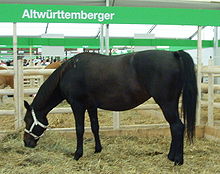Württemberg warmblood
| Württemberg warmblood | |
|---|---|

Victoria Winter with the Württemberg warmblood Proton at the Kentucky Cup 2010 |
|
| Important data | |
| Origin: | Main and state stud Marbach |
| Main breeding area: | Baden-Württemberg |
| Distribution: | low, approx. 100 breeding stallions and approx. 3,900 broodmares |
| Stick measure : | 160-175 cm |
| Colors : | often foxes and browns |
| Main application area: | Riding and driving, agricultural work |
The württemberger - including Baden-Wuerttemberg - is a warm-blooded - home breed , bred mainly in Marbach stud . Their original cultivated form is now called Altwürttemberger .
Background information on horse evaluation and breeding can be found under: Exterior , interior and horse breeding .
Exterior
The modern Württemberger is a typical German sport horse whose exterior largely corresponds to the defined breeding goal of the German warmblood associations. The breeding goal is described as follows: The appearance of an elegant, large-lined and harmonious riding horse is desirable. The imprint of noble blood should be expressed in a dry and expressive head, a large eye, well-formed neck, plastic muscles and correct, clear limbs. Breeding stallions and broodmares should have a clear gender expression. The Baden-Württemberg Breeding Association specifies a height of 160 to 177 cm, while foxes, browns, blacks, molds and piebalds are permitted as colors.
Although there has been a lot of breeding with Hanoverian , Holstein and Oldenburg stallions in Baden-Württemberg in recent years , you can still see in many Württemberg stallions that there were a lot of Trakehner stallions in use during the rebreeding phase from light work horses to modern riding horses . The people of Württemberg owe their often very noble heads to them. In addition, thoroughbred Arabian stallions who have inherited hardness and nobility were repeatedly used in Württemberg .
interior
The Württemberger is a sensitive horse, suitable for both riding and driving, who is known for his endurance and good rideability.
Breeding history
The development and breeding of the Württemberger is closely linked to the history of today's main and state stud in Marbach. The stud was founded as a court stud by Count Eberhard V. as early as 1460 and taken over by his son Christoph , who expanded it in 1554 and defined the improvement of the previously inferior state breeding as a breeding goal.
Over the centuries, the stud changed hands several times and, depending on the dedication and expertise of the respective duke, both the number of horses and their quality fluctuated greatly.
From 1744 to 1793 the mare master Georg Hartmann worked in Marbach, who, due to his expertise , must be regarded as a healing antipole to the owner at the time, Carl Eugen , who was very active but also extremely fickle.
The stud book and with it the really systematic breeding began in 1895. The original breeding goal was a heavy workhorse that was also to be suitable as a riding horse. First, Arabian stallions were crossed with local mares. The Suffolk and Clydesdales cold-blooded breeds were used briefly to achieve greater caliber, but soon no longer played a role in the breed's development. Oldenburger , Nonius and Normänner had a stronger influence .
However, the breed was not consolidated until the middle of the 19th century by the head stable master von Hofacker, whose success had been preceded by many experiments. The breakthrough for the Wuerttemberg breed was achieved through the import and breeding of the two standard stallions Comet and Faust , who presented themselves with resounding inheritance.
After the Second World War , the need for workhorses decreased drastically in favor of machines. The then Landstallmeister Dr. Georg Wenzler then managed to acquire the stallion that was to become the progenitor of today's Württemberg warmblood: Julmond . The Trakehner was no longer young when he came to the main and state stud in Marbach after long madness and confusion - among other things, he had covered in Warendorf in the Westphalia breeding program, but did not strike there - but brought his sons Amor and Lothar with him who, together with him, ennobled the previously rather difficult Württembergers.

Altwürttemberger
The original medium-weight horses are bred by a few owners under the name Altwürttemberger . Although this breed is threatened with extinction , it always provides a stallion for state breeding, such as the Altwürttemberger Abendruf , who for years caused a sensation as an action trotter at the stallion demonstrations of the main and state stud Marbach and also produced some very good dressage horses.
Recent development
At the end of the 20th century, other warmblood breeds, especially Holsteiners , were increasingly used in order to further improve the frame, caliber and jumping ability of the Württemberg man. For this purpose, a refinement phase has started again in the stud, which is particularly characterized by thoroughbreds such as Heraldik xx .
See also
swell
- Breeding goal for the German sport horse, German Equestrian Association, Warendorf
- Sibylle Luise Binder: Horses of the World - Warmbloods . Müller-Rüschlikon Verlag, Switzerland



